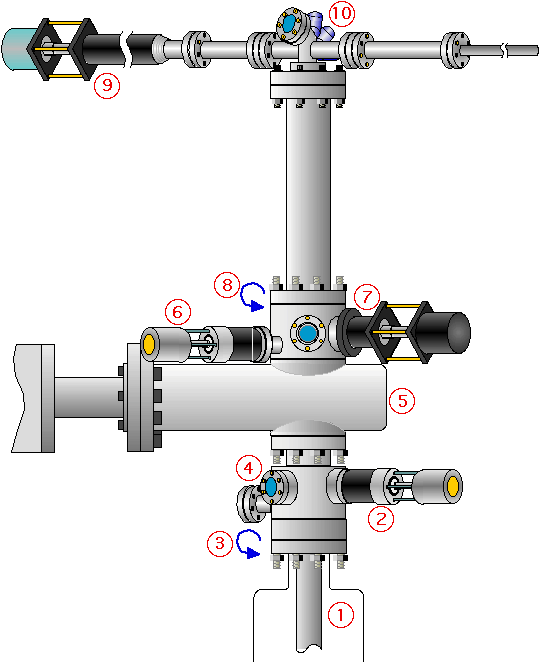
New Mexico Geochronology Research Laboratory
Hardware — Resistance Furnace
Note: The description of hardware below is out of date and will be revised soon.
The resistance furnace used by the NMGRL is essentially...
- Advantages of a resistance furnace
- homogenous heating of bulk samples
- good temperature control (necessary for obtaining thermal histories from plutonic potassium feldspar)
- capable of analyzing large quantities of material (e.g. very young or low potassium samples)
- Disadvantages of a resistance furnace
- large extraction background or blank levels
- single-crystal analysis not feasible for most samples
- slow in comparison to CO2 laser system

Illustration of the NMGRL furnace and furnace sample loading system.
-
Double-vacuum furnace with molybdenum crucible which contains an inexpensive, removable molybdenum liner to increase life of the crucible.
-
Shutter, shaft-mounted onto a linear actuator with 1 inch of travel.
-
1.33 inch flange with flex-line connected to analytical vacuum system.
-
1.33 inch flange equipped with 0.75 inch zero-length viewport for visual examination of funnel assembly.
-
VAT Series 48 all-metal gate valve with saphire window welded into the valve. Provides for visual examination of crucible floor during sample heating.
-
Shutter shaft-mounted onto a linear actuator with 1" of travel. Shutter is equipped with cup to catch any stray sample grains and a 0.25" diameter in-vacuo mirror. The mirror is mounted to provide viewing access, through a zero-length viewport (similar to 4), to the bottom of the crucible during sample heating.
-
Rotory actuator driven by a DC stepper motor. Actuator drives small in-vacuo gears which in turn drive tubular funnel up and down. The funnel, normally 'nested' in the 7" long nipple, is lowered when a fresh sample (contained in 9) is dropped into the furnace crucible. The apparatus decreases the chance of in-vacuo contamination from earlier samples and allows for computer-controlled sample loading.
-
1.33" flange on opposite side of drawing. Provides access to non-analytical "roughing" section.
-
Linear actuator driven by a DC stepper motor. Computer controlled actuator manuevers one of 17 stainless steel sample buckets into position to be dumped into the furnace crucible.
-
Three electromagnets, fired successively, to dump samples out of buckets into furnace crucible. A viewport (similar to 4) allows visual access to the sample drop.



